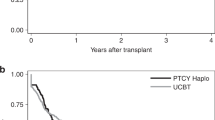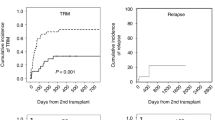Abstract
Graft failure is a major concern after cord blood transplantation (CBT) or HLA-haploidentical transplantation (haplo-SCT). As patients who undergo CBT or haplo-SCT almost always lack both matched-related and -unrelated donors, salvage transplantation would also be limited to either CBT or haplo-SCT. In this study, we assessed eight patients who received haplo-SCT as salvage therapy for graft failure. Five and three patients had received haplo-SCT and CBT, respectively, which resulted in graft failure. The median interval from the failed transplantation to salvage transplantation in six patients with primary graft failure was 33.5 days. The reduced-intensity conditioning regimen consisted of fludarabine, thiotepa, rabbit antithymocyte globulin and low-dose TBI. All eight patients achieved neutrophil engraftment, and seven patients achieved platelet recovery. The median times to neutrophil recovery and platelet recovery were 10 and 20 days, respectively. Three patients died from treatment-related causes: two from GVHD and one from rupture of carotid artery aneurysm. Five patients are alive, at a median follow-up of 946 days. The probability of overall survival at 5 years was 75%. These findings may serve as a rationale for giving precedence to haplo-SCT over CBT in salvage SCT after graft failure.
This is a preview of subscription content, access via your institution
Access options
Subscribe to this journal
Receive 12 print issues and online access
$259.00 per year
only $21.58 per issue
Buy this article
- Purchase on Springer Link
- Instant access to full article PDF
Prices may be subject to local taxes which are calculated during checkout
Similar content being viewed by others
References
Donohue J, Homge M, Kernan NA . Characterization of cells emerging at the time of graft failure after bone marrow transplantation from an unrelated marrow donor. Blood 1993; 82: 1023–1029.
Martin PJ, Akatsuka Y, Hahne M, Sale G . Involvement of donor T-cell cytotoxic effector mechanisms in preventing allogeneic marrow graft rejection. Blood 1998; 92: 2177–2181.
Ottinger HD, Rebmann V, Pfeiffer KA, Beelen DW, Kremens B, Runde V et al. Positive serum crossmatch as predictor for graft failure in HLA-mismatched allogeneic blood stem cell transplantation. Transplantation 2002; 73: 1280–1285.
Taylor PA, Ehrhardt MJ, Roforth MM, Swedin JM, Panoskaltsis-Mortari A, Serody JS et al. Preformed antibody, not primed T cells, is the initial and major barrier to bone marrow engraftment in allosensitized recipients. Blood 2007; 109: 1307–1315.
Quinones RR . Hematopoietic engraftment and graft failure after bone marrow transplantation. Am J Pediatr Hematol Oncol 1993; 15: 3–17.
Steffens HP, Podlech J, Kurz S, Angele P, Dreis D, Reddehase MJ . Cytomegalovirus inhibits the engraftment of donor bone marrow cells by downregulation of hemopoietin gene expression in recipient stroma. J Virol 1998; 72: 5006–5015.
McSweeney PA, Niederwieser D, Shizuru JA, Sandmaier BM, Molina AJ, Maloney DG et al. Hematopoietic cell transplantation in older patients with hematologic malignancies: replacing high-dose cytotoxic therapy with graft-versus-tumor effects. Blood 2001; 97: 3390–3400.
Martin PJ, Hansen JA, Buckner CD, Sanders JE, Deeg HJ, Stewart P et al. Effects of in vitro depletion of T cells in HLA-identical allogeneic marrow grafts. Blood 1985; 66: 664–672.
Laughlin MJ, Barker J, Bambach B, Koc ON, Rizzieri DA, Wagner JE et al. Hematopoietic engraftment and survival in adult recipients of umbilical-cord blood from unrelated donors. N Engl J Med 2001; 344: 1815–1822.
Baron F, Maris MB, Storer BE, Sandmaier BM, Panse JP, Chauncey TR et al. High doses of transplanted CD34+ cells are associated with rapid T-cell engraftment and lessened risk of graft rejection, but not more graft-versus-host disease after nonmyeloablative conditioning and unrelated hematopoietic cell transplantation. Leukemia 2005; 19: 822–828.
Anasetti C, Amos D, Beatty PG, Appelbaum FR, Bensinger W, Buckner CD et al. Effect of HLA compatibility on engraftment of bone marrow transplants in patients with leukemia or lymphoma. N Engl J Med 1989; 320: 197–204.
Laughlin MJ, Eapen M, Rubinstein P, Wagner JE, Zhang MJ, Champlin RE et al. Outcomes after transplantation of cord blood or bone marrow from unrelated donors in adults with leukemia. N Engl J Med 2004; 351: 2265–2275.
Rocha V, Labopin M, Sanz G, Arcese W, Schwerdtfeger R, Bosi A et al. Transplants of umbilical-cord blood or bone marrow from unrelated donors in adults with acute leukemia. N Engl J Med 2004; 351: 2276–2285.
McCann SR, Bacigalupo A, Gluckman E, Hinterberger W, Hows J, Ljungman P et al. Graft rejection and second bone marrow transplants for acquired aplastic anaemia: a report from the Aplastic Anaemia Working Party of the European Bone Marrow Transplant Group. Bone Marrow Transplant 1994; 13: 233–237.
Guardiola P, Kuentz M, Garban F, Blaise D, Reiffers J, Attal M et al. Second early allogeneic stem cell transplantations for graft failure in acute leukaemia, chronic myeloid leukaemia and aplastic anaemia. French Society of Bone Marrow Transplantation. Br J Haematol 2000; 111: 292–302.
Platzbecker U, Binder M, Schmid C, Rutt C, Ehninger G, Bornhauser M . Second donation of hematopoietic stem cells from unrelated donors for patients with relapse or graft failure after allogeneic transplantation. Haematologica 2008; 93: 1276–1278.
Schriber J, Agovi MA, Ho V, Ballen KK, Bacigalupo A, Lazarus HM et al. Second unrelated donor hematopoietic cell transplantation for primary graft failure. Biol Blood Marrow Transplant 2010; 16: 1099–1106.
Ogawa H, Ikegame K, Yoshihara S, Kawakami M, Fujioka T, Masuda T et al. Unmanipulated HLA 2-3 antigen-mismatched (haploidentical) stem cell transplantation using nonmyeloablative conditioning. Biol Blood Marrow Transplant 2006; 12: 1073–1084.
Tamaki H, Ikegame K, Kawakami M, Fujioka T, Tsuboi A, Oji Y et al. Successful engraftment of HLA-haploidentical related transplants using nonmyeloablative conditioning with fludarabine, busulfan and anti-T-lymphocyte globulin. Leukemia 2003; 17: 2052–2054.
Przepiorka D, Weisdorf D, Martin P, Klingemann HG, Beatty P, Hows J et al. 1994 Consensus Conference on Acute GVHD Grading. Bone Marrow Transplant 1995; 15: 825–828.
Waki F, Masuoka K, Fukuda T, Kanda Y, Nakamae M, Yakushijin K et al. Feasibility of reduced-intensity cord blood transplantation as salvage therapy for graft failure: results of a nationwide survey of 80 adult patients. Biol Blood Marrow Transplant 2010 (e-pub ahead of print 16 September 2010).
Kim EH, Ikegame K, Kawakami M, Nishida S, Fujioka T, Taniguchi Y et al. Unmanipulated reduced-intensity stem cell transplantation from a haploidentical donor mismatched at 3 HLA antigens to a patient with leukemic transformation of myelodysplastic syndrome: successful second transplantation after graft rejection. Int J Hematol 2004; 80: 449–452.
Xu LP, Huang XJ . Successful second transplantation from haploidentical donor for graft failure following unrelated cord blood cell transplantation or mismatched related transplantation: 2 cases report. Chin Med J (Engl) 2006; 119: 1489–1493.
Lang P, Mueller I, Greil J, Bader P, Schumm M, Pfeiffer M et al. Retransplantation with stem cells from mismatched related donors after graft rejection in pediatric patients. Blood Cells Mol Dis 2008; 40: 33–39.
Fernandes J, Rocha V, Robin M, de Latour RP, Traineau R, Devergie A et al. Second transplant with two unrelated cord blood units for early graft failure after haematopoietic stem cell transplantation. Br J Haematol 2007; 137: 248–251.
Jabbour E, Rondon G, Anderlini P, Giralt SA, Couriel DR, Champlin RE et al. Treatment of donor graft failure with nonmyeloablative conditioning of fludarabine, antithymocyte globulin and a second allogeneic hematopoietic transplantation. Bone Marrow Transplant 2007; 40: 431–435.
Chewning JH, Castro-Malaspina H, Jakubowski A, Kernan NA, Papadopoulos EB, Small TN et al. Fludarabine-based conditioning secures engraftment of second hematopoietic stem cell allografts (HSCT) in the treatment of initial graft failure. Biol Blood Marrow Transplant 2007; 13: 1313–1323.
Byrne BJ, Horwitz M, Long GD, Gasparetto C, Sullivan KM, Chute J et al. Outcomes of a second non-myeloablative allogeneic stem cell transplantation following graft rejection. Bone Marrow Transplant 2008; 41: 39–43.
Bolanos-Meade J, Luznik L, Muth M, Matsui WH, Huff CA, Smith BD et al. Salvage transplantation for allograft failure using fludarabine and alemtuzumab as conditioning regimen. Bone Marrow Transplant 2009; 43: 477–480.
Deeg HJ, O’Donnell M, Tolar J, Agarwal R, Harris RE, Feig SA et al. Optimization of conditioning for marrow transplantation from unrelated donors for patients with aplastic anemia after failure of immunosuppressive therapy. Blood 2006; 108: 1485–1491.
Acknowledgements
We thank the medical, nursing and laboratory staff of the participating departments for their contributions to this study. We are also grateful to Ms Aki Yano and Ms Kimiko Yamamoto for their excellent technical assistance and to Ms Saori Hatemura, Mr Shigeo Kimura and Ms Kazuko Saida for their assistance with data collection. This study was supported in part by a grant from the Ministry of Health, Labor and Welfare, Japan.
Author information
Authors and Affiliations
Corresponding author
Ethics declarations
Competing interests
The authors declare no conflict of interest.
Rights and permissions
About this article
Cite this article
Yoshihara, S., Ikegame, K., Taniguchi, K. et al. Salvage haploidentical transplantation for graft failure using reduced-intensity conditioning. Bone Marrow Transplant 47, 369–373 (2012). https://doi.org/10.1038/bmt.2011.84
Received:
Accepted:
Published:
Issue Date:
DOI: https://doi.org/10.1038/bmt.2011.84
Keywords
This article is cited by
-
Non-relapse cytopenias following allogeneic stem cell transplantation, a case based review
Bone Marrow Transplantation (2022)
-
Salvage HLA-haploidentical hematopoietic stem cell transplantation with post-transplant cyclophosphamide for graft failure in non-malignant disorders
Bone Marrow Transplantation (2021)
-
Comparison of the outcomes after haploidentical and cord blood salvage transplantations for graft failure following allogeneic hematopoietic stem cell transplantation
Bone Marrow Transplantation (2020)
-
Feasibility of salvage cord blood transplantation using a fludarabine, melphalan, and low-dose anti-thymocyte globulin conditioning regimen
International Journal of Hematology (2019)
-
Successful early unmanipulated haploidentical transplantation with reduced-intensity conditioning for primary graft failure after cord blood transplantation in hematologic malignancy patients
Bone Marrow Transplantation (2015)



